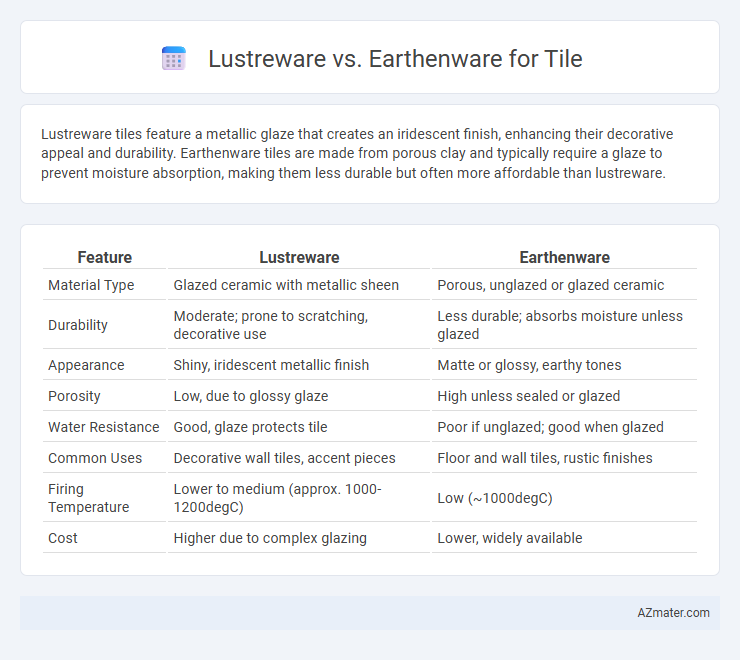Lustreware tiles feature a metallic glaze that creates an iridescent finish, enhancing their decorative appeal and durability. Earthenware tiles are made from porous clay and typically require a glaze to prevent moisture absorption, making them less durable but often more affordable than lustreware.
Table of Comparison
| Feature | Lustreware | Earthenware |
|---|---|---|
| Material Type | Glazed ceramic with metallic sheen | Porous, unglazed or glazed ceramic |
| Durability | Moderate; prone to scratching, decorative use | Less durable; absorbs moisture unless glazed |
| Appearance | Shiny, iridescent metallic finish | Matte or glossy, earthy tones |
| Porosity | Low, due to glossy glaze | High unless sealed or glazed |
| Water Resistance | Good, glaze protects tile | Poor if unglazed; good when glazed |
| Common Uses | Decorative wall tiles, accent pieces | Floor and wall tiles, rustic finishes |
| Firing Temperature | Lower to medium (approx. 1000-1200degC) | Low (~1000degC) |
| Cost | Higher due to complex glazing | Lower, widely available |
Understanding Lustreware: Definition and Characteristics
Lustreware is a type of ceramic tile characterized by its iridescent, metallic glaze achieved through a special firing process involving metallic oxides, resulting in a reflective surface with a shimmering effect. Unlike earthenware, which is porous and typically coated with a matte or glossy glaze, lustreware offers enhanced durability and a distinctive decorative appeal ideal for ornamental tiling. The unique optical qualities of lustreware make it a favored choice for artistic and architectural applications requiring vibrant, lustrous finishes.
What is Earthenware? Key Features Explained
Earthenware is a type of ceramic made from natural clay fired at relatively low temperatures, typically between 1,000degC and 1,150degC, resulting in a porous, slightly softer material compared to other ceramics. Key features include its porous nature, which requires glazing to become water-resistant, and its rich, warm tones ranging from red to buff, making it ideal for decorative and functional tiles. Unlike lustreware, which has a metallic glaze, earthenware tiles emphasize durability and a rustic aesthetic suited for both indoor and outdoor use.
Historical Evolution: Lustreware and Earthenware Tiles
Lustreware tiles originated in the medieval Islamic world, characterized by a metallic sheen achieved through a complex glazing process involving metal oxides, which later influenced European ceramic traditions during the Renaissance. Earthenware tiles, with origins tracing back to ancient Mesopotamia, are made from porous clay fired at lower temperatures and typically feature tin-glaze decoration, making them widely accessible and popular in historical architectural applications. The evolution of lustreware and earthenware tiles reflects technological advancements and cultural exchanges, shaping the decorative arts landscape across centuries.
Visual Appeal: Comparing Aesthetic Qualities
Lustreware tiles feature a shimmering, iridescent glaze that creates a dynamic, reflective surface, enhancing the visual appeal with rich, vibrant colors and intricate patterns. Earthenware tiles offer a more rustic, matte finish, emphasizing natural textures and earthy tones that complement traditional and organic design styles. Comparing aesthetic qualities, lustreware is ideal for creating eye-catching, luxurious spaces, while earthenware provides a warm, timeless charm suited for cozy, rustic environments.
Durability and Longevity: Which Lasts Longer?
Lustreware tiles feature a metallic glaze that offers moderate durability but can be prone to scratching and wear over time. Earthenware tiles are generally more porous and less resistant to moisture, making them less durable in high-traffic or wet areas compared to Lustreware. For longevity, Lustreware provides a harder surface suitable for decorative applications, while earthenware requires proper sealing and maintenance to extend its lifespan.
Maintenance Needs: Caring for Lustreware vs Earthenware
Lustreware tiles require gentle cleaning with non-abrasive materials to preserve their iridescent glaze and prevent surface damage, making regular dusting and wiping essential for maintaining their sheen. Earthenware tiles demand more frequent sealing and are prone to absorb moisture and stains, necessitating thorough cleaning with pH-neutral cleaners to avoid deterioration. Both materials benefit from prompt spill management, but lustreware's delicate finish demands more careful handling compared to the porous nature of earthenware.
Cost Comparison: Budgeting for Tile Projects
Lustreware tiles often carry a higher price point than earthenware due to their intricate glaze techniques and reflective finish, making them a premium choice for tile projects. Earthenware tiles, typically more affordable, offer budget-friendly options suitable for large-scale installations without sacrificing basic durability. When budgeting, consider that the cost difference may impact project scope, as lustreware suits accent areas while earthenware works well for extensive coverage.
Application Suitability: Best Uses for Each Type
Lustreware tiles are ideal for decorative applications, such as backsplashes and accent walls, due to their reflective glaze and vibrant colors that add a luxurious aesthetic. Earthenware tiles offer excellent suitability for low-traffic indoor flooring and wall cladding, providing durability with a more rustic, matte finish that enhances traditional or Mediterranean-style interiors. Both types require proper sealing for moisture-prone areas, but earthenware's porosity makes it less suitable for high-moisture environments compared to lustreware.
Environmental Impact: Sustainability Factors
Lustreware tiles often involve glazing techniques that require higher energy consumption during firing, increasing their environmental footprint compared to earthenware tiles, which typically use lower-temperature kilns. Earthenware's natural clay composition and lower firing temperatures contribute to reduced carbon emissions and energy use, making it a more sustainable choice for eco-conscious projects. The biodegradable nature and greater recyclability of earthenware further enhance its environmental benefits over lustreware in sustainable tile applications.
Choosing the Right Tile: Expert Recommendations
Lustreware tiles feature a metallic glaze that enhances durability and adds a reflective sheen, making them ideal for decorative spaces where visual impact is key. Earthenware tiles, composed of porous clay, offer excellent breathability and a rustic aesthetic, suited for low-traffic areas or traditional designs. Experts recommend selecting Lustreware for high-moisture environments due to its water resistance, while Earthenware is preferred for its affordability and natural texture in dry, indoor settings.

Infographic: Lustreware vs Earthenware for Tile
 azmater.com
azmater.com